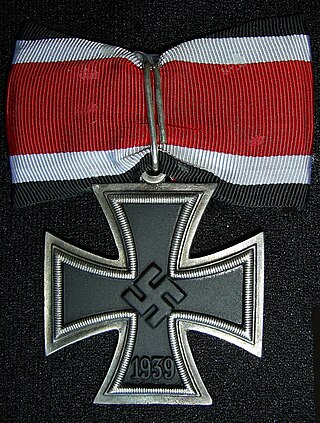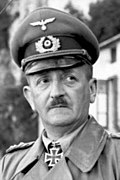Top Qs
Timeline
Chat
Perspective
List of Knight's Cross of the Iron Cross recipients (V)
From Wikipedia, the free encyclopedia
Remove ads
The Knight's Cross of the Iron Cross (German: Ritterkreuz des Eisernen Kreuzes) and its variants were the highest awards in the military and paramilitary forces of Nazi Germany during World War II. The Knight's Cross of the Iron Cross was awarded for a wide range of reasons and across all ranks, from a senior commander for skilled leadership of his troops in battle to a low-ranking soldier for a single act of extreme gallantry.[1] A total of 7,321 awards were made between its first presentation on 30 September 1939 and its last bestowal on 17 June 1945.[Note 1] This number is based on the analysis and acceptance of the order commission of the Association of Knight's Cross Recipients (AKCR). Presentations were made to members of the three military branches of the Wehrmacht—the Heer (Army), Kriegsmarine (Navy) and Luftwaffe (Air Force)—as well as the Waffen-SS, the Reichsarbeitsdienst (RAD—Reich Labour Service) and the Volkssturm (German national militia). There were also 43 recipients in the military forces of allies of the Third Reich.[3]
These recipients are listed in the 1986 edition of Walther-Peer Fellgiebel's book, Die Träger des Ritterkreuzes des Eisernen Kreuzes 1939–1945 [The Bearers of the Knight's Cross of the Iron Cross 1939–1945]. Fellgiebel was the former chairman and head of the order commission of the AKCR. In 1996, the second edition of this book was published with an addendum delisting 11 of these original recipients. Author Veit Scherzer has cast doubt on a further 193 of these listings. The majority of the disputed recipients had been nominated for the award in 1945, when the deteriorating situation of Germany during the final days of World War II left a number of nominations incomplete and pending in various stages of the approval process.[4]
Listed here are the 92 Knight's Cross recipients whose last name starts with "V".[5] Scherzer has challenged the validity of five of these listings.[6] The recipients are ordered alphabetically by last name. The rank listed is the recipient's rank at the time the Knight's Cross was awarded.
Remove ads
Background
Summarize
Perspective
The Knight's Cross of the Iron Cross and its higher grades were based on four separate enactments. The first enactment, Reichsgesetzblatt I S. 1573 of 1 September 1939 instituted the Iron Cross (Eisernes Kreuz), the Knight's Cross of the Iron Cross and the Grand Cross of the Iron Cross (Großkreuz des Eisernen Kreuzes). Article 2 of the enactment mandated that the award of a higher class be preceded by the award of all preceding classes.[7] As the war progressed, some of the recipients of the Knight's Cross distinguished themselves further and a higher grade, the Knight's Cross of the Iron Cross with Oak Leaves (Ritterkreuz des Eisernen Kreuzes mit Eichenlaub), was instituted. The Oak Leaves, as they were commonly referred to, were based on the enactment Reichsgesetzblatt I S. 849 of 3 June 1940.[8] In 1941, two higher grades of the Knight's Cross were instituted. The enactment Reichsgesetzblatt I S. 613 of 28 September 1941 introduced the Knight's Cross of the Iron Cross with Oak Leaves and Swords (Ritterkreuz des Eisernen Kreuzes mit Eichenlaub und Schwertern) and the Knight's Cross of the Iron Cross with Oak Leaves, Swords and Diamonds (Ritterkreuz des Eisernen Kreuzes mit Eichenlaub, Schwertern und Brillanten).[9] At the end of 1944 the final grade, the Knight's Cross of the Iron Cross with Golden Oak Leaves, Swords, and Diamonds (Ritterkreuz des Eisernen Kreuzes mit goldenem Eichenlaub, Schwertern und Brillanten), based on the enactment Reichsgesetzblatt 1945 I S. 11 of 29 December 1944, became the final variant of the Knight's Cross authorized.[10]
Remove ads
Recipients
Summarize
Perspective
The Oberkommando der Wehrmacht (Supreme Command of the Armed Forces) kept separate Knight's Cross lists for the Heer (Army), Kriegsmarine (Navy), Luftwaffe (Air Force) and Waffen-SS. Within each of these lists a unique sequential number was assigned to each recipient. The same numbering paradigm was applied to the higher grades of the Knight's Cross, one list per grade.[11] Of the 92 awards made to servicemen whose last name starts with "V", seven were later awarded the Knight's Cross of the Iron Cross with Oak Leaves and seven presentations were made posthumously. Heer members received 68 of the medals, one went to the Kriegsmarine, 17 to the Luftwaffe, and six to the Waffen-SS.[5]
This along with the + (plus) indicates that a higher grade of Knight's Cross was awarded as well.
This along with the ? (question mark) indicates that author Veit Scherzer has expressed doubt regarding the veracity and formal correctness of the listing.
Remove ads
Notes
- Großadmiral and President of Germany Karl Dönitz, Hitler's successor as Head of State (Staatsoberhaupt) and Supreme Commander of the Armed Forces, had ordered the cessation of all promotions and awards as of 11 May 1945 (Dönitz-decree). Consequently the last Knight's Cross awarded to Oberleutnant zur See of the Reserves Georg-Wolfgang Feller on 17 June 1945 must therefore be considered a de facto but not de jure hand-out.[2]
- For an explanation of the various naming schemes used by the Luftwaffe, Heer, Kriegsmarine and Waffen-SS refer to nomenclature used by the Wehrmacht and Waffen-SS.
- According to Scherzer as chief of the 6./SS-Kavallerie-Regiment 15 and leader of a Kampfgruppe.[14]
- No evidence of the award can be found in the German Federal Archives. Fellgiebel assumes a presentation via the chief of the Heerespersonalamt (HPA—Army Staff Office) Wilhelm Burgdorf in Berlin. This scenario is very unlikely since the commanding Oder corps, and most likely also Fritz Vierecker's emergency unit, had both been deployed south of Stettin under the command of the Army Group Vistula.[20] His nomination should therefore have been submitted via the command chain of the Army Group Vistula. Additionally the radio connection to the Führerbunker was down since 5:00 on 28 April 1945. Vierecker is not mentioned anywhere in the proceedings of the Order Commission of the Association of Knight's Cross Recipients (AKCR). His family holds a portrait picture of Vierecker wearing the Knight's Cross of the Iron Cross. The Knight's Cross at his neck evidently is not a photomontage. Noteworthy is the fact that Vierecker wears his peace time uniform of Pionier-Battalion 12 (12th pioneer battalion) on this picture.[22]
- No evidence of the award can be found in the German Federal Archives. The award was unlawfully presented by the commanding general of the I. Falschirmkorps, General der Fallschirmtruppe Richard Heidrich.[22]
- No evidence of the award can be found in the German Federal Archives. According to Fellgiebel presented on 1 June 1945 by the AOK 6, which was not authorized. Helmut Vögtle is member of the Association of Knight's Cross Recipients.[24]
- No evidence of the award can be found in the German Federal Archives. The Order Commission of the Association of Knight's Cross Recipients (AKCR) stated: "...Generalmajor Hans Voigt has to be considered a bearer of the Knight's Cross of the Iron Cross, even though the formalities are not 100 percent correct." because the presentation was an "authorized presentation by Himmler" as commander-in-chief of Army Group Vistula from the end of February or early March. Himmler was not authorized to make this presentation, a fact known to the AKCR, however the AKCR wanted to affiliate Voigt immediately. The AKCR therefore assigned the unsuspicious presentation date of 28 April 1945 and claimed its approval was made by the chief of the Heerespersonalamt (HPA—Army Staff Office) Wilhelm Burgdorf in Berlin. His listing by Fellgiebel contains a footnote stating "It has to be assumed that a few presentations have been made by the chief of the HPA General Burgdorf in the timeframe 20 April to 30 April." Voigt was a member of the AKCR.[22][28]
- No evidence of the award can be found in the German Federal Archives. Werner Voshage is also not mentioned in the activity reports of the Association of Knight's Cross Recipients (AKCR). The only indication can be found in a letter of the AKCR to Friedrich Müller-Rochholz dated from 16 June 1980 which claims that Voshage may have been nominated in mid-March. According to the AKCR the award was presented in accordance with the Dönitz-decree. This is illegal according to the Deutsche Dienststelle (WASt) and lacks legal justification. The presentation date is an assumption of the AKCR.[24]
Remove ads
References
External links
Wikiwand - on
Seamless Wikipedia browsing. On steroids.
Remove ads








